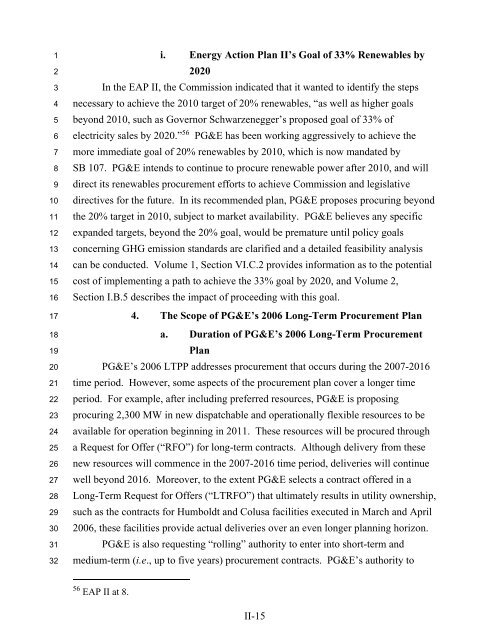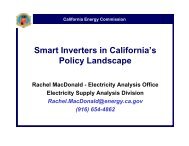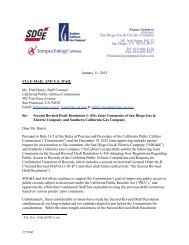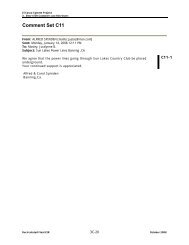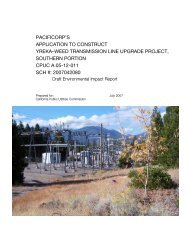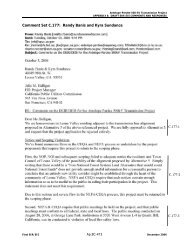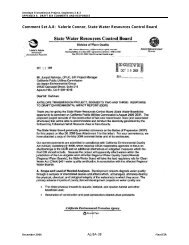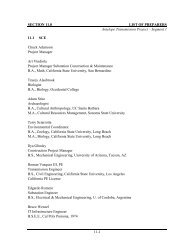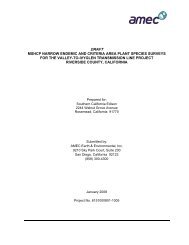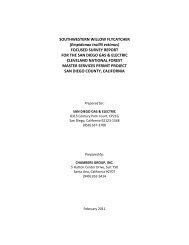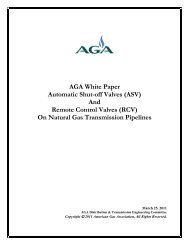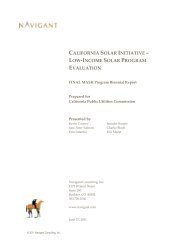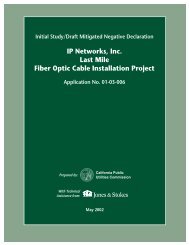Volume I. Part I - California Public Utilities Commission
Volume I. Part I - California Public Utilities Commission
Volume I. Part I - California Public Utilities Commission
You also want an ePaper? Increase the reach of your titles
YUMPU automatically turns print PDFs into web optimized ePapers that Google loves.
1<br />
2<br />
3<br />
4<br />
5<br />
6<br />
7<br />
8<br />
9<br />
10<br />
11<br />
12<br />
13<br />
14<br />
15<br />
16<br />
17<br />
18<br />
19<br />
20<br />
21<br />
22<br />
23<br />
24<br />
25<br />
26<br />
27<br />
28<br />
29<br />
30<br />
31<br />
32<br />
i. Energy Action Plan II’s Goal of 33% Renewables by<br />
2020<br />
In the EAP II, the <strong>Commission</strong> indicated that it wanted to identify the steps<br />
necessary to achieve the 2010 target of 20% renewables, “as well as higher goals<br />
beyond 2010, such as Governor Schwarzenegger’s proposed goal of 33% of<br />
electricity sales by 2020.” 56 PG&E has been working aggressively to achieve the<br />
more immediate goal of 20% renewables by 2010, which is now mandated by<br />
SB 107. PG&E intends to continue to procure renewable power after 2010, and will<br />
direct its renewables procurement efforts to achieve <strong>Commission</strong> and legislative<br />
directives for the future. In its recommended plan, PG&E proposes procuring beyond<br />
the 20% target in 2010, subject to market availability. PG&E believes any specific<br />
expanded targets, beyond the 20% goal, would be premature until policy goals<br />
concerning GHG emission standards are clarified and a detailed feasibility analysis<br />
can be conducted. <strong>Volume</strong> 1, Section VI.C.2 provides information as to the potential<br />
cost of implementing a path to achieve the 33% goal by 2020, and <strong>Volume</strong> 2,<br />
Section I.B.5 describes the impact of proceeding with this goal.<br />
4. The Scope of PG&E’s 2006 Long-Term Procurement Plan<br />
a. Duration of PG&E’s 2006 Long-Term Procurement<br />
Plan<br />
PG&E’s 2006 LTPP addresses procurement that occurs during the 2007-2016<br />
time period. However, some aspects of the procurement plan cover a longer time<br />
period. For example, after including preferred resources, PG&E is proposing<br />
procuring 2,300 MW in new dispatchable and operationally flexible resources to be<br />
available for operation beginning in 2011. These resources will be procured through<br />
a Request for Offer (“RFO”) for long-term contracts. Although delivery from these<br />
new resources will commence in the 2007-2016 time period, deliveries will continue<br />
well beyond 2016. Moreover, to the extent PG&E selects a contract offered in a<br />
Long-Term Request for Offers (“LTRFO”) that ultimately results in utility ownership,<br />
such as the contracts for Humboldt and Colusa facilities executed in March and April<br />
2006, these facilities provide actual deliveries over an even longer planning horizon.<br />
PG&E is also requesting “rolling” authority to enter into short-term and<br />
medium-term (i.e., up to five years) procurement contracts. PG&E’s authority to<br />
56 EAP II at 8.<br />
II-15


